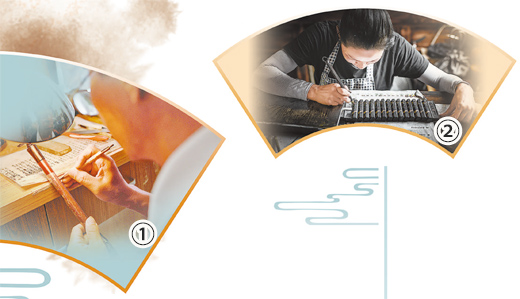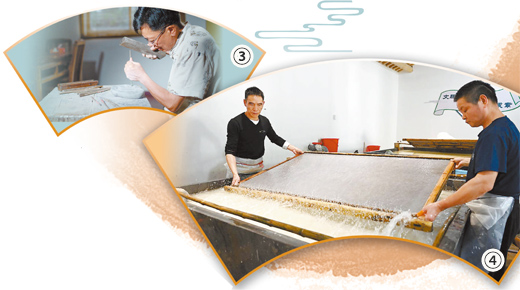




- BRNN
- BRI News
- BRNN News
- Database
Official Documents Polices and Regulations
Inter-government Documents International Cooperation BRI Countries
Business Guide Economic Data BRI Data
Trade
Investment Projects Latest projects
Cases - Content Pool
The techniques of making Huzhou ink brushes, Huizhou inksticks, Xuan paper, and Duan inkstones—representing the "Four Treasures of the Study," an esteemed collection of tools used in traditional Chinese calligraphy and painting—have all been inscribed into the first batch of China's national intangible cultural heritage list. These crafts have been well preserved and passed down across generations.

①: An artisan works on a Huzhou ink brush. (Photo/Shen Yongqiang)
②: A worker works on Huizhou inksticks. (Photo courtesy of the publicity department of the Communist Party of China Shexian county committee)
Huzhou ink brush
Shanlian town in Nanxun district, Huzhou city, east China's Zhejiang Province is known for making the Huzhou ink brush, or Hu brush, one of the prestigious writing brush types in traditional Chinese writing and painting art.
The production of a Huzhou ink brush involves 12 major procedures. Qiu Changming, a national-level inheritor of the techniques of making Huzhou ink brushes, has dedicated 45 years to one specific procedure of the craft. Like him, the vast majority of workers at the Shanlian Huzhou Ink Brush Factory in Shanlian town devote themselves to a single process, committing their entire careers to perfecting that process.
In 2023, Huzhou city issued regulations to protect and promote the development of Huzhou ink brushes. Simultaneously, Nanxun district introduced a special plan for the ink brush, establishing a collaborative protection framework among government, society, schools, and enterprises.
At a store run by a renowned family of Huzhou ink brush makers, visitors are greeted by an array of exquisitely crafted cultural and creative products related to the ink brush. The post-90s generation store owner, Yao Yulin, who is Qiu's last apprentice, said innovative designs relevant to the ink brush particularly appeal to young people.
In recent years, a new generation of Huzhou ink brush artisans, represented by Yao, has continued to innovate—opening online stores, creating short videos, and hosting livestreams—to introduce the ink brush to broader audiences.

③: Yang Zhuozhong, a national-level representative inheritor of Duan inkstone making techniques, works on a Duan inkstone. (Photo/Wu Yisheng)
④: Workers make Xuan paper at a workshop in Xuancheng city, east China's Anhui Province. (Xinhua/Zhou Mu)
Huizhou inkstick
The Huizhou inkstick, or Huimo in Chinese, is one of the sterling examples of China's high-quality ink products. Huizhou inksticks originate from Huizhou, today's Huangshan city in east China's Anhui Province.
Making ink involves complex techniques and a secret formula: smoke refining, glue mixing, shaping, drying, decorating, gilding, packaging, and mold making.
Two smoke types are used — pine soot and oil soot. For pine soot, pine branches are burned in 80-meter-long smoke kilns, and soot is scraped from the walls after cooling. For oil soot, sealed smoke rooms are used. Oil lamps are lit with rush wicks, and porcelain bowls cover the flames to collect soot inside.
Once soot and glue are mixed, the dough is pounded again on heated platforms. Workers then roll the dough into balls, press them into molds, cool, and demold. After prolonged drying, skilled hands paint gold inscriptions. The whole process takes months or even years.
The resulting ink is glossy black with a strong scent, leaving writing that can last for centuries without fading — truly, "as dark as lacquer, enduring for ages."
"The Huizhou inkstick is an essential carrier of Chinese culture. It's our responsibility to inherit its making techniques and help more people to appreciate and use it," said Zhou Meihong, a national-level inheritor of Huizhou inkstick making techniques and head of the Ancient Hu Kaiwen Ink Factory located in Shexian county, Huangshan city.
The factory was founded by Hu Kaiwen, one of the four great Huizhou ink masters in the Qing Dynasty (1644-1911). In 1915, the factory's inkstick products won a gold medal during the Panama Pacific International Exposition.
Since 2017, the factory has developed 40 sets of cultural and creative products annually, generating cumulative revenue of approximately 26 million yuan ($3.6 million). To date, it has produced over 1,000 products that enjoy high reputations domestically and are also exported to Japan and South Korea.
The factory's annual sales volume via livestream sessions reaches about 16 million yuan, said Zhou Jian, director of the factory's product development department.
"Through communication with online followers during livestreams, we gain insights into young people's preferences for inkstick sizes, patterns, and packaging. This gives us clearer direction for production," Zhou Jian said. More importantly, livestreaming helps promote traditional culture, allowing more people to understand and experience Huizhou inksticks.
Xuan paper
Originating in Anhui Province's Jingxian county, which was under the jurisdiction of Xuanzhou in the Tang Dynasty (618-907), Xuan paper has a history of over 1,000 years and is known for its long lifespan.
The traditional technique includes over 100 steps, involving raw material processing, pulp preparation, and papermaking. Bark from sandalwood trees and rice straw are transformed into pulp, which is then turned into paper through scooping, drying, trimming, and packaging. Most steps still cannot be mechanized. The entire process takes up to three years and each sheet is the result of sweat and dedication.
"Xuan paper is not just a craft but also a national cultural icon. Treating the making of Xuan paper as an art form has increased my sense of pride and responsibility," said Zhou Donghong, a provincial-level inheritor of Xuan paper-making techniques.
In Wuxi village of Jingxian county, the Xuan Paper Town, covering nearly 3-square kilometers, attracted over 400,000 tourist visits in 2024, generating nearly 20 million yuan in economic benefits.
In Dingjiaqiao town, Jingxian county, there are over 1,100 merchants operating in an e-commerce cluster dedicated to Xuan paper, with annual shipments exceeding 5 million orders. More than 2,000 people work in the Xuan paper e-commerce sector and related industries, with per capita annual income surpassing 50,000 yuan.
To further support the Xuan paper industry, Jingxian county has established a large Xuan Paper market in the Dingjiaqiao town industrial park, covering areas such as trade in the four treasures of study, cultural tourism, art exchanges, artist reception, e-commerce, and logistics services. In 2024, industries related to the four treasures of study in Xuancheng city generated revenue of nearly 2 billion yuan.
Duan inkstone
Once known as Duanzhou, Zhaoqing city in south China's Guangdong Province is famous for the Duan inkstone, which has been celebrated nationwide since the early Tang Dynasty. Duan inkstones are prized for their fine stone quality, unique patterns, and exquisite carvings.
The craft boasts a 1,400-year history. Traditionally, inkstone craftsmen followed strict rules of secrecy, adhering to ancestral codes that forbade sharing skills with outsiders. But in modern times, artisans have broken with this secrecy, openly accepting apprentices and passing down their techniques to promote and preserve the tradition.
There are 29 representative inheritors (including those deceased) of Duan inkstone making techniques, over 800 professional technical talents, and more than 12,000 practitioners.
Before this year's Spring Festival, a magnificent Duan inkstone work donated by Zhaoqing city to the Bai'etan Greater Bay Area Art Center in Guangzhou, capital of Guangdong Province, captured widespread attention. Created by Yang Zhuozhong, a national-level representative inheritor of the craft, the artwork depicts the Pearl River's scenery, inlaid with Guangzhou's landmark buildings, showcasing the city's vibrant spirit and status as a pioneer of reform and opening up.
Such innovation has become a trend, giving rise to cultural and creative products that integrate other crafts, such as ornamental timepieces and fridge magnets.
Due to the rarity of Duan inkstone materials, Zhaoqing halted all inkstone mining in 2000 and introduced regulations to protect its resources. To preserve and promote Duan inkstone culture, relevant departments have worked to cultivate artistic masters and representative inheritors, support inkstone artisans in establishing national-level productive protection demonstration bases for the craft, and introduce Duan inkstone culture and carving techniques to primary and secondary schools.
"After enduring thousands of years of change, the Duan inkstone is no longer just a scholar's tool," says Luo Jianquan, 16th-generation inkstone carver of the Luo family and a provincial-level inheritor of the craft. "It has become a living heritage, imprinted with the marks of historical development and cultural continuity."
"To make traditional craftsmanship resonate with the pulse of the times—that is my duty," Luo added with conviction.

Tel:86-10-65363107, 86-10-65368220, 86-10-65363106